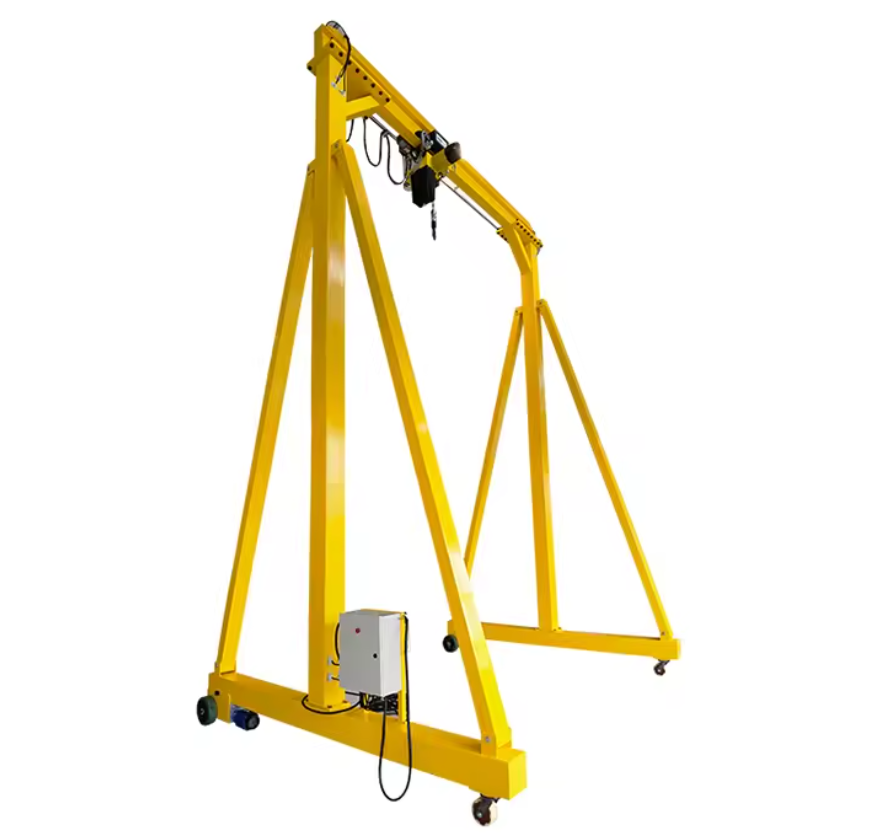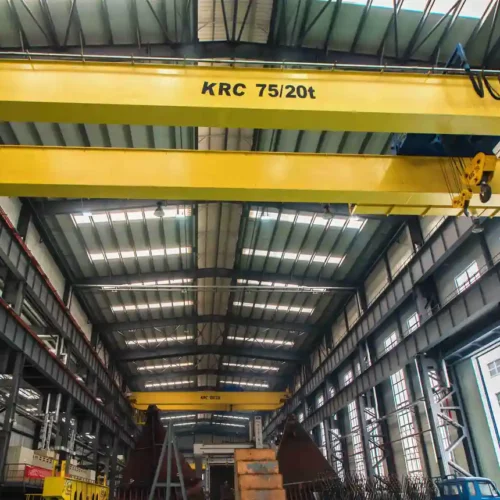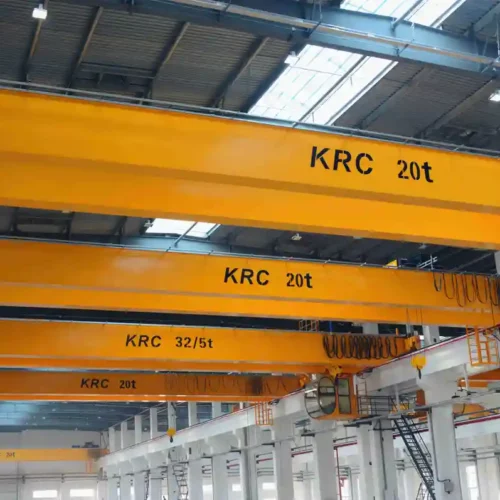1 ton gantry crane Safety Certifications
When selecting a 1-ton gantry crane, ensuring it meets appropriate safety certifications is crucial for safe and compliant operation. Here are key certifications to look for:
1. Occupational Safety and Health Administration (OSHA): Cranes should comply with OSHA standards outlined in 29 CFR 1910.179, addressing construction, use, and maintenance.
2. American National Standards Institute (ANSI): ANSI B30.17 covers safety standards for overhead and gantry cranes, ensuring structural integrity and operational safety.
3. American Society of Mechanical Engineers (ASME): ASME B30.2 and B30.20 provide guidance on handling and inspections of lifting devices and associated safety precautions.
4. European Conformity (CE) Marking: For cranes used in Europe, the CE marking indicates compliance with the Machinery Directive 2006/42/EC, ensuring the equipment meets health and safety requirements.
5. International Organization for Standardization (ISO): ISO 9001 certification ensures a quality management system (QMS) is in place, crucial for consistent safety and performance standards.
6. Canadian Standards Association (CSA): In Canada, compliance with CSA C22.2 standards ensures electrical and operational safety for cranes.
Yearly inspections, staff training in proper use, maintenance schedules, and adherence to the manufacturer’s guidelines are vital for safely operating a 1-ton gantry crane. Always ask for proof of these certifications before making a purchase to ensure long-term safety and compliance.
List Reference Technical Parameters of “1 ton gantry crane”
A 1-ton gantry crane is a versatile lifting device designed for various industrial and construction applications. Below are the key technical parameters:
1. Load Capacity:
– Maximum Load: 1 ton (1000 kg)
2. Span:
– Distance Between Legs: Variable, typically ranges from 3 to 8 meters, customizable based on specific requirements.
3. Lift Height:
– Maximum Lift Height: Generally ranges from 3 to 6 meters, customizable.
4. Construction Material:
– High-strength steel or aluminum for lightweight models.
5. Mobility:
– Fixed or mobile: Mobile models come with castor wheels (lockable for stability).
6. Beam Type:
– I-beam or box girder, designed to support the rated load.
7. Power Supply:
– Manual, electric, or pneumatic.
8. Hoist Type:
– Electric, manual chain, or wire rope hoist compatible.
9. Controls:
– Pendant control, remote control, or push-button control for electric models.
10. Speed:
– Lifting Speed: Varies; electric hoists approximately 0.2 to 1 m/min.
– Travel Speed: For powered trolley, approximately 0.2 to 1 m/min.
11. Safety Features:
– Overload protection
– Safety latches on hooks
– Emergency stop features
– Limit switches for upper and lower lift limits
12. Dimensions:
– Width, height, and length are customizable.
– Example: Width around 2 to 4 meters and height around 3 to 5 meters, depending on the application.
13. Assembly:
– Typically modular for ease of assembly and disassembly.
14. Environmental Resistance:
– Coatings to resist corrosion
– Suitable for indoor and limited outdoor use
These parameters provide a comprehensive understanding of a 1-ton gantry crane’s capabilities and applications. Always ensure compliance with local safety regulations and standards when selecting and operating such equipment.
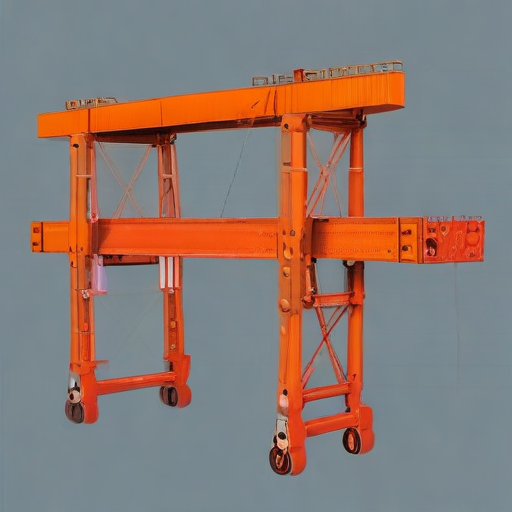
List Product features of “1 ton gantry crane”
A 1-ton gantry crane is a versatile and essential tool in various industries. Here are its key product features:
1. Load Capacity: Can lift up to 1 ton (2,000 lbs), making it suitable for medium-weight materials.
2. Construction: Generally made from high-strength steel, ensuring durability and longevity.
3. Adjustable Height: Offers adjustable height to cater to different lifting needs and workspace requirements.
4. Mobility: Fitted with casters or wheels for easy movement and positioning within a workspace.
5. Ease of Assembly and Disassembly: Designed for quick setup and takedown, enhancing portability and storage.
6. Versatility: Suitable for use in various settings including workshops, warehouses, and construction sites.
7. Stability and Safety: Equipped with locking mechanisms on wheels and a robust frame to ensure safe operation.
8. Weather Resistance: Often coated with powder or galvanized finish for rust and corrosion resistance.
9. Manual or Motorized Operation: Available in both manual and motorized versions for ease of lifting.
10. Cost-Effective: Provides an economical solution for lifting needs compared to permanent lifting structures.
11. Customizable Options: Can be customized for height, span, and tread width to meet specific application requirements.
12. Compliance: Meets industry safety and quality standards for lifting equipment.
In summary, a 1-ton gantry crane is a reliable, flexible, and efficient tool for lifting and moving heavy items in various environments. Its key features include high load capacity, robust construction, adjustable height, mobility, and user-friendly design.
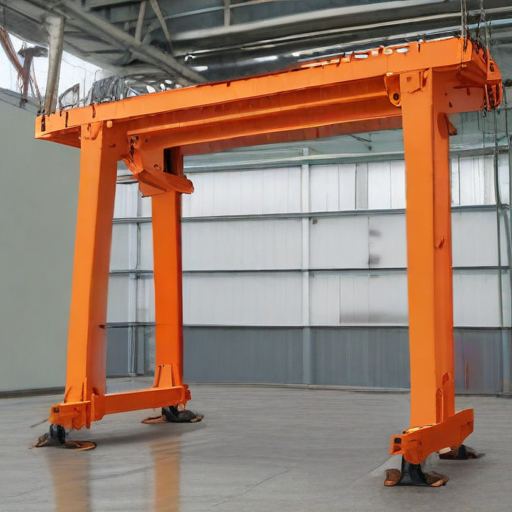
List Application of “1 ton gantry crane”
A 1-ton gantry crane is a versatile lifting device widely used in various industries for handling loads up to 1 ton. Here are some key applications:
1. Warehousing and Logistics:
– Moving heavy pallets and containers
– Loading and unloading trucks
– Positioning materials within storage racks
2. Manufacturing:
– Assembling heavy machinery and components
– Transporting raw materials and finished goods
– Precise placement of parts on assembly lines
3. Construction:
– Lifting construction materials such as beams and pipes
– Assisting in the assembly of scaffolding
– Positioning equipment and tools on-site
4. Maintenance:
– Servicing heavy machinery and vehicles
– Replacing large parts such as engines or gearboxes
– Facility maintenance, including HVAC systems
5. Metal Fabrication:
– Handling steel plates and metal sheets
– Assisting in welding operations by holding parts in place
– Moving finished metal products
6. Automotive:
– Lifting car engines and transmissions
– Handling large automotive parts and accessories
– Assisting in assembling and disassembling vehicles
7. Aerospace:
– Transporting aircraft components
– Assisting in the assembly of airplanes and spacecraft
– Moving tools and equipment in hangars and maintenance facilities
8. Marine:
– Handling marine equipment and boat parts
– Assisting in shipbuilding and repair
– Moving cargo on docks and in shipyards
9. Agriculture:
– Lifting farm equipment and machinery
– Handling large bales of hay and other agricultural products
– Assisting in the maintenance of tractors and other vehicles
10. Retail:
– Setting up large displays and store layouts
– Moving inventory in large retail warehouses
– Assisting in the installation of signage
Overall, the 1-ton gantry crane enhances efficiency and safety by enabling easy and precise handling of heavy loads in a controlled manner.
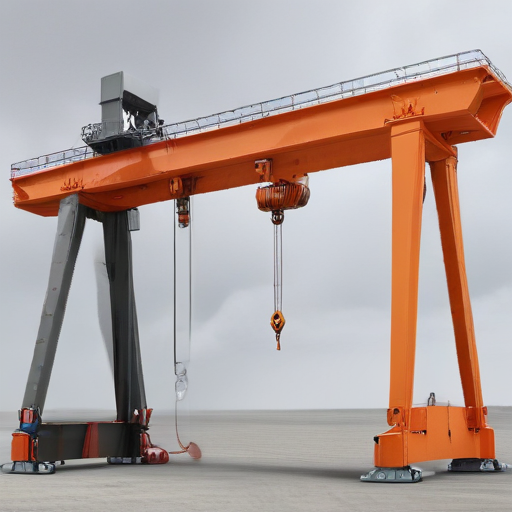
List Various Types of “1 ton gantry crane”
A 1-ton gantry crane is a versatile lifting device used in various industries for material handling and lifting tasks. Here are some different types of 1-ton gantry cranes:
1. Adjustable Height Gantry Cranes: These cranes allow the user to adjust the height of the beam and legs, making it versatile for different lifting heights. They are ideal for settings where varying space clearances are needed.
2. Fixed Height Gantry Cranes: These cranes have a non-adjustable height, offering a simpler, cost-effective solution for environments where the height requirement is constant.
3. Portable Gantry Cranes: Designed for mobility, these cranes have wheels or casters that facilitate easy movement across different areas of a workspace. They are suited for environments where lifting tasks need to be performed at various locations.
4. Aluminum Gantry Cranes: Made from lightweight aluminum, these cranes are corrosion-resistant and easy to transport. They are commonly used in applications requiring frequent setup and breakdown.
5. Steel Gantry Cranes: These cranes are constructed from high-strength steel, providing greater durability and load-bearing capacity than aluminum alternatives. They are better suited for heavy-duty applications.
6. Motorized Gantry Cranes: Equipped with motorized travel, these cranes offer enhanced efficiency and ease of operation. They are ideal for larger facilities where manual movement is impractical.
7. A-Frame Gantry Cranes: Featuring A-shaped legs, these cranes provide stable support and are commonly used in light to medium-duty applications.
8. Single Leg Gantry Cranes: Also known as semi-gantry cranes, these have one leg running on ground rails and the other running on an elevated rail or track, making them suitable for space-constrained environments.
Each type of 1-ton gantry crane has its unique benefits and applications, allowing users to select the most appropriate model based on their specific needs and operational constraints.
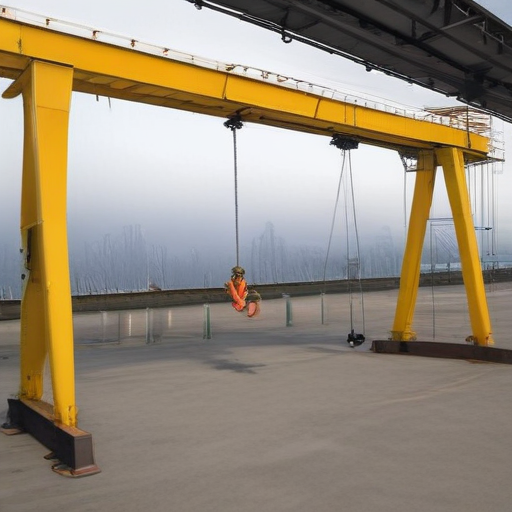
1 ton gantry crane Accessories Upgrades and Custom Manufacturing Options
Upgrading your 1-ton gantry crane with the right accessories and custom manufacturing options can significantly enhance its performance, safety, and versatility. Below are some key options to consider:
Accessories:
1. Electric Hoists:
– Upgrade from a manual chain hoist to an electric hoist for quicker and more efficient lifting operations.
2. Remote Control Systems:
– Add wireless or wired remote controls to enhance operator safety and operational flexibility.
3. Festoon Systems:
– Implement cable management systems to keep power and control cables organized and secure, reducing the risk of damage.
4. End Stops and Bumpers:
– Install mechanical end stops or rubber bumpers to prevent the trolley and hoist from over-traveling and causing accidents.
5. Caster Wheel Upgrades:
– Opt for heavy-duty or all-terrain caster wheels to improve mobility on uneven surfaces.
Custom Manufacturing Options:
1. Adjustable Height:
– Custom-fabricate the crane with an adjustable height feature to cater to varied lifting requirements and improve versatility.
2. Custom Span and Length:
– Modify the span and length to fit specific workspace dimensions and operational needs.
3. Material Coatings:
– Apply specialized coatings such as galvanization or powder-coating for enhanced durability and corrosion resistance, especially in harsh environments.
4. Specialized Hooks and Lifting Attachments:
– Utilize custom hooks, slings, or spreader bars to handle unique load shapes and requirements effectively.
5. Load Monitoring Systems:
– Integrate digital load cells and monitoring systems to provide real-time load data, ensuring safe lifting practices.
Conclusion:
Enhancing your 1-ton gantry crane with these accessories and custom options can lead to safer, more efficient, and more adaptable lifting operations. Select upgrades tailored to your specific operational needs to maximize productivity and safety.
List Quality Control and The Manufacturing Process of “1 ton gantry crane”
Quality Control
1. Material Inspection: Raw materials, including steel and components, undergo rigorous inspection to ensure they meet specified standards.
2. Supplier Verification: Approved suppliers are regularly audited for quality compliance.
3. In-Process Monitoring: Continuous checks are conducted throughout the manufacturing process to ensure adherence to design specifications.
4. Non-Destructive Testing (NDT): Techniques such as ultrasonic, radiographic, and magnetic particle testing are utilized to detect internal and surface defects.
5. Load Testing: The gantry crane is subjected to load tests to verify its structural integrity and performance under its rated capacity of 1 ton.
6. Dimensional Inspection: Precision measuring tools are used to confirm that all parts and assemblies are within specified tolerances.
7. Final Assembly Inspection: A thorough inspection is performed after assembly to ensure all components are correctly installed and functional.
8. Safety Compliance: Ensures the crane meets relevant safety standards and regulations.
9. Documentation: Comprehensive records of quality checks and tests are maintained for traceability and accountability.
10. Customer Feedback: Post-delivery feedback is reviewed for continuous improvement.
Manufacturing Process
1. Design and Engineering: CAD software is used to create detailed designs and plans for the crane, including structural analysis and load calculations.
2. Material Procurement: Quality raw materials like high-strength steel are sourced according to specifications.
3. Cutting and Shaping: CNC machines and plasma cutters are used to shape structural components precisely.
4. Welding: Parts are welded together using MIG or TIG welding techniques to ensure strong, durable joints.
5. Machining: Components such as wheels, pulleys, and shafts are machined to their final dimensions.
6. Surface Treatment: Parts undergo treatments like shot blasting, galvanizing, or powder coating to enhance corrosion resistance and longevity.
7. Assembly: Components are assembled following detailed instructions, with care taken to ensure alignment and fit.
8. Electrical System Installation: Electrical components, including control panels, motors, and wiring, are installed and tested.
9. Quality Testing: The assembled crane undergoes a series of tests, including load tests, to ensure it meets performance and safety standards.
10. Packaging and Shipping: The crane is carefully packed to prevent damage during transportation and shipped to the customer.
These steps ensure that the 1-ton gantry crane is manufactured to high standards of quality and reliability.
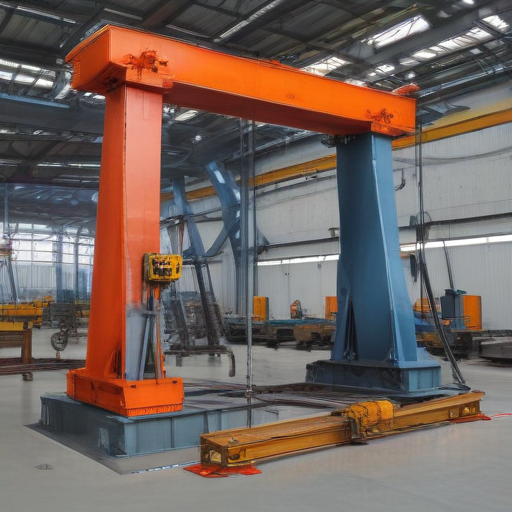
How to use “1 ton gantry crane”
A 1-ton gantry crane is a versatile piece of equipment used for lifting and moving heavy loads. Follow these steps to safely and effectively use a 1-ton gantry crane:
Preparation
1. Inspection: Before use, inspect the crane for any damage or wear, paying close attention to the legs, wheels, beams, and lifting mechanism.
2. Area Clearance: Ensure the area is clear of obstacles and people to provide a safe working environment.
3. Load Assessment: Confirm the weight of the load does not exceed 1 ton and ensure the load is evenly balanced.
Setup
1. Positioning: Move the gantry crane to the desired location using its wheels. Lock the wheels to prevent movement while lifting.
2. Assemble: If the crane is not pre-assembled, follow the manufacturer’s instructions to assemble it securely.
Operation
1. Attachment: Attach the hoist or lifting mechanism to the load securely using appropriate slings or chains.
2. Lifting: Slowly lift the load by operating the hoist, ensuring it is stable and balanced. Stop lifting if any instability occurs.
3. Movement: Once lifted, carefully move the crane to transport the load. Ensure the path is clear and avoid swift movements.
4. Lowering: Slowly lower the load to its new position by operating the lowering mechanism on the hoist.
Post-Operation
1. Detachment: Once the load is safely on the ground, detach the slings or chains.
2. Inspection: Inspect the crane again for any signs of wear or damage post-operation.
3. Storage: Move the crane to a designated storage area and lock the wheels.
Important Tips
– Always follow the manufacturer’s instructions and safety guidelines.
– Use appropriate personal protective equipment (PPE).
– Never exceed the crane’s rated capacity of 1 ton.
By adhering to these guidelines, you can safely and efficiently use a 1-ton gantry crane for various lifting tasks.
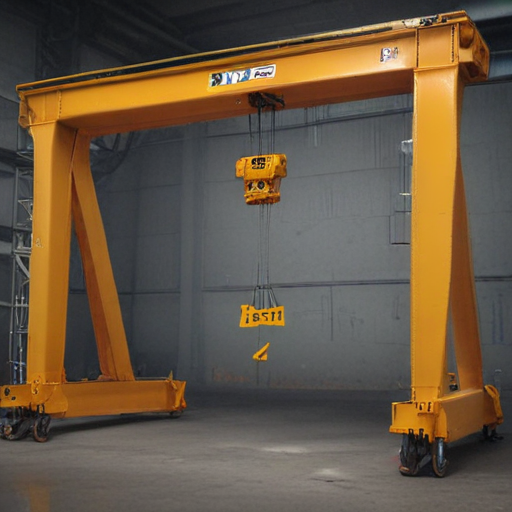
“1 ton gantry crane” Comparative Analysis
When selecting a 1-ton gantry crane, it’s essential to analyze various factors such as material, mobility, adjustability, cost, and application to make a well-informed decision.
Material: Gantry cranes are generally made of steel or aluminum. Steel cranes are robust and durable, making them ideal for heavy-duty applications. In contrast, aluminum cranes are lightweight, corrosion-resistant, and easily portable, perfect for environments where frequent repositioning is required.
Mobility: Depending on your needs, gantry cranes can be stationary, portable, or adjustable. Portable gantry cranes are equipped with caster wheels, which facilitate easy movement around the workspace. Conversely, stationary cranes are fixed and provide stability for repetitive lifting tasks in a confined area.
Adjustability: Adjustable height gantry cranes provide flexibility, allowing you to modify the lifting height to suit various tasks. These cranes can be more versatile and adaptable to different workflows and environments.
Cost: Costs vary significantly depending on the features and material. Steel gantry cranes, although durable, can be more expensive due to their robust construction. Aluminum models are often cheaper but may not suit all heavy-duty requirements. Additionally, adjustable and portable models tend to be pricier due to their added versatility.
Application: Industrial environments with regular, heavy lifting tasks may benefit from a robust steel crane, potentially stationary or semi-portable. Conversely, maintenance or light-duty environments, such as workshops or small warehouses, might opt for the more flexible and lightweight aluminum cranes.
Conclusion: The choice of a 1-ton gantry crane heavily depends on the specific needs of your application. For heavy-duty, repetitive lifting, a sturdy, stationary steel crane might be best. Conversely, for flexibility and ease of movement, an aluminum adjustable crane would be more appropriate. Balancing these factors against your budget will help you make the optimal decision.
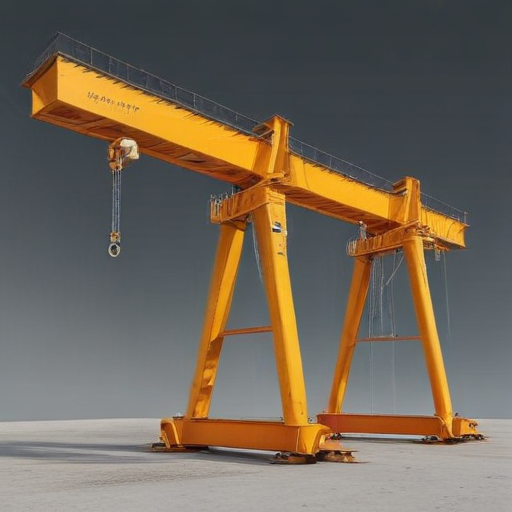
“1 ton gantry crane” Warranty and Support
When considering the purchase of a 1-ton gantry crane, evaluating the warranty and support options is crucial to ensure the longevity and reliability of your investment. Typically, reputable manufacturers provide a standard warranty that covers the crane for a period ranging from one to three years. This warranty usually covers defects in materials and workmanship, ensuring that any issues arising from these causes will be addressed by the manufacturer at no extra cost. It is important to thoroughly review the warranty terms, noting what is and isn’t covered, as well as any conditions that might void the warranty, such as improper use or unauthorized modifications.
In addition to the warranty, robust support services are essential. Good manufacturers offer comprehensive customer support that includes technical assistance, maintenance services, and readily available spare parts. Technical support should be accessible via multiple channels, such as phone, email, or online chat, and should provide prompt and knowledgeable assistance to resolve any issues that arise during the crane’s operation.
Maintenance services often entail routine inspections and preventive maintenance by certified technicians to ensure the crane remains in optimal working condition and to prevent potential breakdowns. Regular maintenance can extend the lifespan of your crane and enhance its operational efficiency.
Furthermore, the availability of spare parts is a critical aspect of support. Ensure the manufacturer maintains a well-stocked inventory of original equipment manufacturer (OEM) parts to facilitate quick repairs and minimize downtime.
Lastly, consider whether the manufacturer offers training programs for your staff. Proper training can significantly reduce the risk of operational errors and mechanical failures, thereby enhancing safety and efficiency.
In summary, a solid warranty combined with comprehensive support services—including technical assistance, maintenance, spare parts availability, and staff training—provides peace of mind and ensures your 1-ton gantry crane remains a valuable asset for years to come.
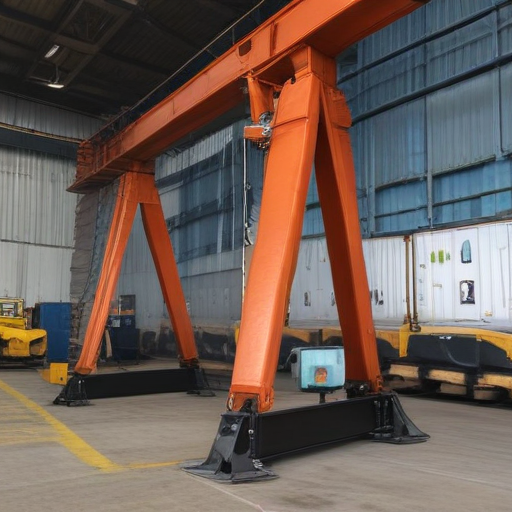
List “1 ton gantry crane” FAQ
1 Ton Gantry Crane FAQ
1. What is a 1-ton gantry crane?
A 1-ton gantry crane is a lifting device designed to lift and move loads up to 1 ton (2,000 lbs). It consists of a horizontal beam (girder) supported by two legs that move on wheels or fixed supports.
2. What are the types of 1-ton gantry cranes available?
Types include fixed-height cranes, adjustable-height cranes, aluminum gantry cranes, and motorized gantry cranes. The choice depends on the application and usage environment.
3. What are the typical applications of a 1-ton gantry crane?
Common applications include workshops, garages, warehouses, construction sites, and manufacturing plants for tasks like lifting heavy machinery, equipment repair, and material handling.
4. What are the benefits of using a 1-ton gantry crane?
Benefits include ease of mobility, versatility, cost-effectiveness, and ability to lift moderate loads without the need for a complex setup or permanent installation.
5. How do I choose the right 1-ton gantry crane?
Consider factors such as load capacity, height, width, beam length, adjustability, mobility, and material (steel or aluminum) based on your specific needs and workspace.
6. How can I ensure safety while using a 1-ton gantry crane?
Follow manufacturer guidelines, perform regular inspections, ensure load does not exceed capacity, use appropriate lifting slings or chains, and train operators thoroughly.
7. What maintenance is required for a 1-ton gantry crane?
Routine maintenance involves checking for structural integrity, inspecting wheels and beams, lubricating moving parts, and ensuring proper function of the hoist mechanism.
8. Can a 1-ton gantry crane be used outdoors?
Yes, but ensure it is rated for outdoor use and inspect for weather-related wear. Portable models are often used for temporary outdoor lifting tasks.
9. How is a 1-ton gantry crane assembled?
Assembly usually involves connecting the legs to the horizontal beam, attaching wheels if required, and securing all bolts and fasteners according to the user manual.
10. Where can I purchase a 1-ton gantry crane?
They are available from industrial suppliers, crane manufacturers, online marketplaces, and specialized equipment retailers.
Always refer to the specific crane’s manual and follow all operational guidelines for safe and effective use.
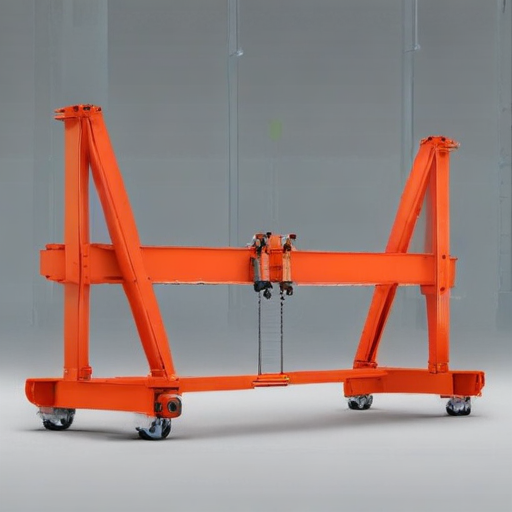
Top 10 FAQ with answer about 1 ton gantry crane for Buyer Sourcing from China
Absolutely! Here are the Top 10 Frequently Asked Questions (FAQ) about sourcing a 1 ton gantry crane from China along with succinct answers.
1. What is a 1 ton gantry crane?
A 1 ton gantry crane is a type of overhead crane with a lifting capacity of 1 ton. It consists of a horizontal beam supported by legs with wheels, allowing it to move materials in an efficient manner within a designated area.
2. What are the common applications?
1 ton gantry cranes are commonly used in workshops, warehouses, manufacturing facilities, and construction sites for lifting and transporting materials and equipment.
3. What are the types of gantry cranes available?
Types include single girder, double girder, portable, adjustable height, and fixed height cranes. The choice depends on your specific application and space requirements.
4. What materials are used in construction?
Typically, high-strength steel is used for the construction of gantry cranes to ensure durability and safety.
5. What standards and certifications should I look for?
Look for ISO, CE, and any industry-specific certifications. These ensure the crane meets international safety and quality standards.
6. What is the lead time for manufacturing and delivery?
The lead time can vary but typically ranges from 4 to 8 weeks, depending on the complexity of the crane and customizations required.
7. How do I ensure the quality of the crane?
Request for factory audits, quality control documentation, and third-party inspection reports. It’s also advisable to visit the manufacturing facility if possible.
8. What shipping methods are available and at what cost?
Shipping can be done via sea, air, or rail. Sea freight is most common due to cost-effectiveness; however, air freight can be quicker. Costs will depend on the shipping method, distance, and volume.
9. What post-purchase support is available?
Ensure the supplier offers a warranty, typically 1 to 2 years, and provides after-sales support including installation guidance, spare parts, and technical assistance.
10. What should I consider for safe operation?
Ensure operators are adequately trained, follow manufacturer guidelines, and conduct regular maintenance checks. Safety features like overload protections, emergency stops, and regular inspections are crucial.
Keeping these FAQs in mind will help you make an informed decision when sourcing a 1 ton gantry crane from China.

